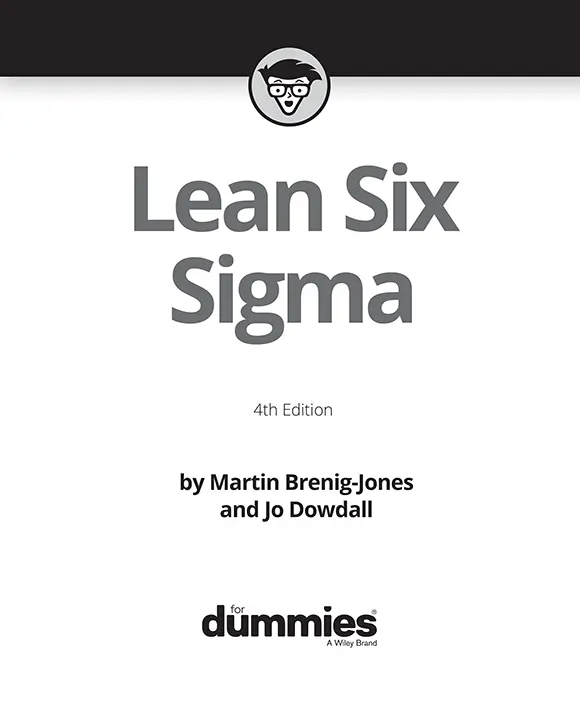
Lean Six Sigma For Dummies®, 4th Edition
Published by: John Wiley & Sons, Inc.,111 River Street, Hoboken, NJ 07030-5774, www.wiley.com
Copyright © 2022 by John Wiley & Sons, Inc., Hoboken, New Jersey
Published simultaneously in Canada
No part of this publication may be reproduced, stored in a retrieval system or transmitted in any form or by any means, electronic, mechanical, photocopying, recording, scanning or otherwise, except as permitted under Sections 107 or 108 of the 1976 United States Copyright Act, without the prior written permission of the Publisher. Requests to the Publisher for permission should be addressed to the Permissions Department, John Wiley & Sons, Inc., 111 River Street, Hoboken, NJ 07030, (201) 748-6011, fax (201) 748-6008, or online at http://www.wiley.com/go/permissions .
Trademarks:Wiley, For Dummies, the Dummies Man logo, Dummies.com, Making Everything Easier, and related trade dress are trademarks or registered trademarks of John Wiley & Sons, Inc., and may not be used without written permission. All other trademarks are the property of their respective owners. John Wiley & Sons, Inc., is not associated with any product or vendor mentioned in this book.
LIMIT OF LIABILITY/DISCLAIMER OF WARRANTY: WHILE THE PUBLISHER AND AUTHORS HAVE USED THEIR BEST EFFORTS IN PREPARING THIS WORK, THEY MAKE NO REPRESENTATIONS OR WARRANTIES WITH RESPECT TO THE ACCURACY OR COMPLETENESS OF THE CONTENTS OF THIS WORK AND SPECIFICALLY DISCLAIM ALL WARRANTIES, INCLUDING WITHOUT LIMITATION ANY IMPLIED WARRANTIES OF MERCHANTABILITY OR FITNESS FOR A PARTICULAR PURPOSE. NO WARRANTY MAY BE CREATED OR EXTENDED BY SALES REPRESENTATIVES, WRITTEN SALES MATERIALS OR PROMOTIONAL STATEMENTS FOR THIS WORK. THE FACT THAT AN ORGANIZATION, WEBSITE, OR PRODUCT IS REFERRED TO IN THIS WORK AS A CITATION AND/OR POTENTIAL SOURCE OF FURTHER INFORMATION DOES NOT MEAN THAT THE PUBLISHER AND AUTHORS ENDORSE THE INFORMATION OR SERVICES THE ORGANIZATION, WEBSITE, OR PRODUCT MAY PROVIDE OR RECOMMENDATIONS IT MAY MAKE. THIS WORK IS SOLD WITH THE UNDERSTANDING THAT THE PUBLISHER IS NOT ENGAGED IN RENDERING PROFESSIONAL SERVICES. THE ADVICE AND STRATEGIES CONTAINED HEREIN MAY NOT BE SUITABLE FOR YOUR SITUATION. YOU SHOULD CONSULT WITH A SPECIALIST WHERE APPROPRIATE. FURTHER, READERS SHOULD BE AWARE THAT WEBSITES LISTED IN THIS WORK MAY HAVE CHANGED OR DISAPPEARED BETWEEN WHEN THIS WORK WAS WRITTEN AND WHEN IT IS READ. NEITHER THE PUBLISHER NOR AUTHORS SHALL BE LIABLE FOR ANY LOSS OF PROFIT OR ANY OTHER COMMERCIAL DAMAGES, INCLUDING BUT NOT LIMITED TO SPECIAL, INCIDENTAL, CONSEQUENTIAL, OR OTHER DAMAGES.
For general information on our other products and services, please contact our Customer Care Department within the U.S. at 877-762-2974, outside the U.S. at 317-572-3993, or fax 317-572-4002. For technical support, please visit https://hub.wiley.com/community/support/dummies .
Wiley publishes in a variety of print and electronic formats and by print-on-demand. Some material included with standard print versions of this book may not be included in e-books or in print-on-demand. If this book refers to media such as a CD or DVD that is not included in the version you purchased, you may download this material at http://booksupport.wiley.com . For more information about Wiley products, visit www.wiley.com .
Library of Congress Control Number: 2021946527
ISBN 978-1-119-79671-8 (pbk); ISBN 978-1-119-79672-5 (ebk); ISBN 978-1-119-79673-2 (ebk)
Lean Six Sigma For Dummies®
To view this book's Cheat Sheet, simply go to www.dummies.comand search for “Lean Six Sigma For Dummies Cheat Sheet” in the Search box.
Table of Contents
1 Cover
2 Title Page
3 Copyright
4 Introduction About This Book Foolish Assumptions Icons Used In This Book Beyond This Book Where to Go From Here
5 Part 1: Understanding Lean Six Sigma Chapter 1: Defining Lean Six Sigma Introducing Lean Thinking Sussing Six Sigma Adding More to the Mix Chapter 2: Understanding the Principles of Lean Six Sigma Considering the Key Principles of Lean Six Sigma Improving Existing Processes: Introducing DMAIC Reviewing Your DMAIC Phases Taking a Pragmatic Approach
6 Part 2: Lean Six Sigma Foundations Chapter 3: Identifying Your Process Customers Understanding the Process Basics Getting a High-Level Picture Chapter 4: Understanding Your Customers’ Needs Considering Kano Obtaining the Voice of the Customer Researching the Requirements Avoiding Bias Considering Critical To Quality Customer Requirements Establishing the Real CTQs Chapter 5: Understanding the Process Finding Out How the Work Gets Done Painting a Picture of the Process Chapter 6: Managing People and Change Getting into the Grey Matter Gaining Acceptance Sizing Up the Status Quo Coping with Change Creating the Vision Busting Assumptions
7 Part 3: Understanding Performance and Analyzing the Process Chapter 7: Gathering Data Managing by Fact Developing a Data Collection Plan Chapter 8: Presenting Your Data Delving into Different Types of Variation Recognizing the Importance of Control Charts Chapter 9: Identifying Root Causes Unearthing the Suspects Generating Your List of Suspects Confirming the Causes Chapter 10: Identifying Non-Value-Adding Steps and Waste Defining Value-Adding Looking at the Eight Wastes Chapter 11: Getting the Process to Flow Applying the Theory of Constraints Managing the Production Cycle Looking at Your Layout
8 Part 4: Improving and Innovating Chapter 12: Thinking Differently and Generating Solutions Getting Immersed in Ideas Prioritizing the Ideas Testing the Ideas to See What Will Fly Chapter 13: Discovering the Opportunity for Prevention Looking at Prevention Tools and Techniques Workplace Organization Using Visual Management Profiting from Preventive Maintenance Avoiding Peaks and Troughs Building in Business Process Robotics Chapter 14: Introducing Design for Six Sigma Introducing DfSS Introducing DMADV Defining What Needs Designing Considering Quality Function Deployment (QFD) Making Decisions Chapter 15: Discovering Design Thinking The Principles of Design Thinking Comparing DMADV and Design Thinking Walking through the Design Thinking Steps Deciding on Design Thinking Chapter 16: Applying Agile to Lean Six Sigma Projects Understanding Agile Principles Embracing an Agile Mindset Succeeding in the Scrum Capitalizing on Kanbans Combining Agile and Lean Six Sigma
9 Part 5: Deploying Lean Six Sigma and Making Change Happen Chapter 17: Running Rapid Improvement Events and Solving Problems with DMAIC Raving about Rapid Improvement Understanding the Facilitator’s Role Creating a Checklist for Running Successful Events Practicing Problem Solving Chapter 18: Ensuring Everyday Operational Excellence Standardizing the Process Making Everyday Operational Excellence a Reality Understanding Organizational Culture Chapter 19: Leading the Deployment and Selecting the Right Projects Considering Key Factors for Successful Deployment Understanding Executive Sponsorship Considering Size and Sector Recognizing the Important Role of Managers Introducing the Deployment Program Manager Starting Your Lean Six Sigma Program Understanding What Project Sponsors Do Driving Strategy Deployment with Lean Six Sigma Generating a List of Candidate Improvement Projects Deciding Whether Lean Six Sigma Is the Right Approach Setting Up a DMAIC Project Chapter 20: Putting It All Together: Checklists to Support Your DMAIC Project Defining the Project Moving into the Measure Phase Analyzing to Identify Root Causes Quantifying the Opportunity Identifying and Planning the Improvements Confirming the Customer and Business Benefits Implementing the Solutions and Controlling the Process Conducting the Final Benefit Review
Читать дальше













